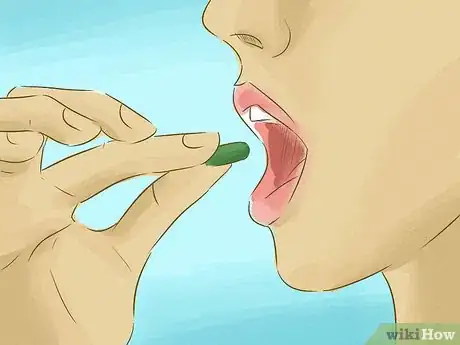This article was medically reviewed by Sarah Gehrke, RN, MS. Sarah Gehrke is a Registered Nurse and Licensed Massage Therapist in Texas. Sarah has over 10 years of experience teaching and practicing phlebotomy and intravenous (IV) therapy using physical, psychological, and emotional support. She received her Massage Therapist License from the Amarillo Massage Therapy Institute in 2008 and a M.S. in Nursing from the University of Phoenix in 2013.
There are 13 references cited in this article, which can be found at the bottom of the page.
This article has been viewed 48,475 times.
Many people with issues from eczema to premenstrual pain report that evening primrose oil (EPO) relieves their symptoms. However, there’s no concrete evidence that EPO can treat any medical condition.[1] If you want to give it a try, take an EPO tablet 4 to 5 times daily. You can also apply a topical oil to relieve skin itchiness and irritation. Whether you use EPO in tablet or topical form, keep it out of direct sunlight and store it in the fridge for up to 6 months, or for as long as recommended by the manufacturer.[2]
Steps
Taking an Oral Tablet
-
1Look for products certified by a third-party organization. Check labels for the certification seal of a standards organization such the United States Pharmacopoeia (USP) or European Pharmacopoeia (Ph. Eur.). Additionally, the bottle should be dark and the label should list an expiration date.
- You can find EPO tablets online, at a local drugstore, or at a vitamins and supplements retailer.
-
2Take up to 2000 mg per day. A general regimen includes taking a 500 mg tablet 4 to 5 times a day. However, it’s best to ask your doctor to recommend the correct dosage.[3]Advertisement
-
3Take a tablet with food to prevent stomach upset. While you can take an EPO tablet without food, taking it with a snack or a meal can prevent nausea and gas, which are potential side effects.[4] Additionally, EPO contains an omega-6 fatty acid. Fatty acids are best absorbed when taken with healthy fats, like nuts or avocado.[5]
-
4Store tablets in the refrigerator. Keep EPO tablets out of direct sunlight. Refrigerate them to keep them from spoiling, and don’t take them after the expiration date listed on the label.
- EPO typically has a shelf life of 6 months or less. Throw the tablets away if they smell rancid.
- Always follow the storage instructions that came with the tablets.
-
5
-
6Take EPO if you have diabetic neuropathy. Some people who suffer from diabetic neuropathy report that EPO helps relieve symptoms of pain, tingling, and numbness. Research is inconclusive, and there’s no concrete evidence that using EPO instead of a prescription medication is beneficial for diabetic neuropathy.[8]
-
7Try taking EPO tablets to treat premenstrual pain. EPO tablets are commonly used to relieve symptoms of premenstrual syndrome (PMS), including headache, bloating, and breast pain. While there’s some evidence that EPO is beneficial, it’s no more effective than less expensive herbal remedies used to treat PMS, including wheat germ and corn oil.[9]
-
8Take it to relieve symptoms of rheumatoid arthritis. EPO may help relieve pain associated with rheumatoid arthritis and reduce dependence on NSAID pain relievers. When using EPO for arthritis, you might not notice any changes for up to 6 months.[10]
- While it might relieve pain, there’s no evidence that EPO prevents or slows down joint damage associated with rheumatoid arthritis. Your best option is to consult a rheumatologist.
-
9Use it to improve your heart health. Since it has anti-inflammatory properties and may help reduce blood cholesterol, EPO may improve overall heart health.[11] However, you should work with your doctor to diagnose and treat any heart disorders.
Applying a Topical Oil
-
1Purchase a water-based emulsion containing 20 percent EPO. EPO topical emulsions are used to treat itchiness and irritation due to eczema and other skin conditions. Look for a product that carries the seal of the USP, Ph. Eur., or other third-party organization.[12]
- Go for a dark-colored container, which will help keep out light.
-
2Wash your hands before and after applying the oil. Your hands should be clean when you apply the oil, so be sure to use soap and hot water. You’ll also need to wash off oil residue when you’re done.
-
3Apply a thin layer of topical EPO to the affected area twice daily. Massage the oil into your skin completely. Since many eczema treatments can’t be used on sensitive areas, such as the face, it could be worth trying EPO if your affected areas include sensitive skin.
- Many people who’ve used topical EPO for eczema report that it relieved their symptoms. However, research is inconclusive, and there’s no definitive proof that topical EPO can manage eczema.[13]
-
4Refrigerate topical EPO. Like tablets, topical EPO should be refrigerated and kept out of direct sunlight for the best results.[14] Store it for up to 6 months, don’t use it after its expiration date, and throw it away if it smells bad.
Using Evening Primrose Safely
-
1Consult your doctor before taking any herb or supplement. It’s especially important to talk to your doctor if you’re trying to treat a serious medical condition. Even if an herb or supplement makes you feel better, you still need to work with your doctor to manage the underlying condition.[15]
- For instance, EPO might reduce pain associated with rheumatoid arthritis or diabetic neuropathy, but it doesn’t actually treat arthritic joint destruction, nerve damage, or diabetes.
-
2Ask your doctor about possible drug interactions. Tell your doctor about any prescription drugs, over the counter medications, herbs, or supplements you regularly take. EPO could negatively interact with blood thinners, such as warfarin. It could also increase the risk of seizures when taken with some medications for epilepsy, schizophrenia, and depression.
-
3Lower your dose or stop taking EPO if you experience side effects. Side effects can include upset stomach, headache, and soft stools. They're usually mild, and lowering your dose can help prevent them.[16]
- Stop taking EPO if you experience severe symptoms or signs of an allergic reaction, such as rash, difficulty breathing, wheezing, or swelling of your hands and feet.
-
4Avoid using EPO if you’re pregnant. There’s some evidence that EPO can cause complications during labor and lead to bruising in newborns. You should also consult your doctor before taking EPO if you’re planning on becoming pregnant or breastfeeding.[17]
References
- ↑ https://nccih.nih.gov/health/eveningprimrose
- ↑ https://www.thieme-connect.com/products/ejournals/abstract/10.1055/s-2006-950007
- ↑ https://www.drugs.com/npp/evening-primrose-oil.html
- ↑ http://cms.herbalgram.org/ABCGuide/GuidePDFs/Evening_Primrose_Oil.pdf
- ↑ https://www.ncbi.nlm.nih.gov/pubmed/2847723
- ↑ https://www.ncbi.nlm.nih.gov/pmc/articles/PMC4252667/
- ↑ https://www.healthline.com/health/evening-primrose-oil#skin-health4
- ↑ http://www.aafp.org/afp/2009/1215/p1405.html
- ↑ https://www.ncbi.nlm.nih.gov/pmc/articles/PMC6718646/
- ↑ http://www.arthritis.org/living-with-arthritis/treatments/natural/supplements-herbs/guide/evening-primrose.php
- ↑ https://www.healthline.com/health/evening-primrose-oil#heart-health9
- ↑ http://cms.herbalgram.org/ABCGuide/GuidePDFs/Evening_Primrose_Oil.pdf
- ↑ http://cms.herbalgram.org/ABCGuide/GuidePDFs/Evening_Primrose_Oil.pdf
- ↑ https://www.thieme-connect.com/products/ejournals/abstract/10.1055/s-2006-950007
- ↑ https://nccih.nih.gov/health/supplements/wiseuse.htm#hed6
- ↑ https://www.healthline.com/health/evening-primrose-oil#skin-health4
- ↑ https://www.mskcc.org/cancer-care/integrative-medicine/herbs/evening-primrose-oil










































































